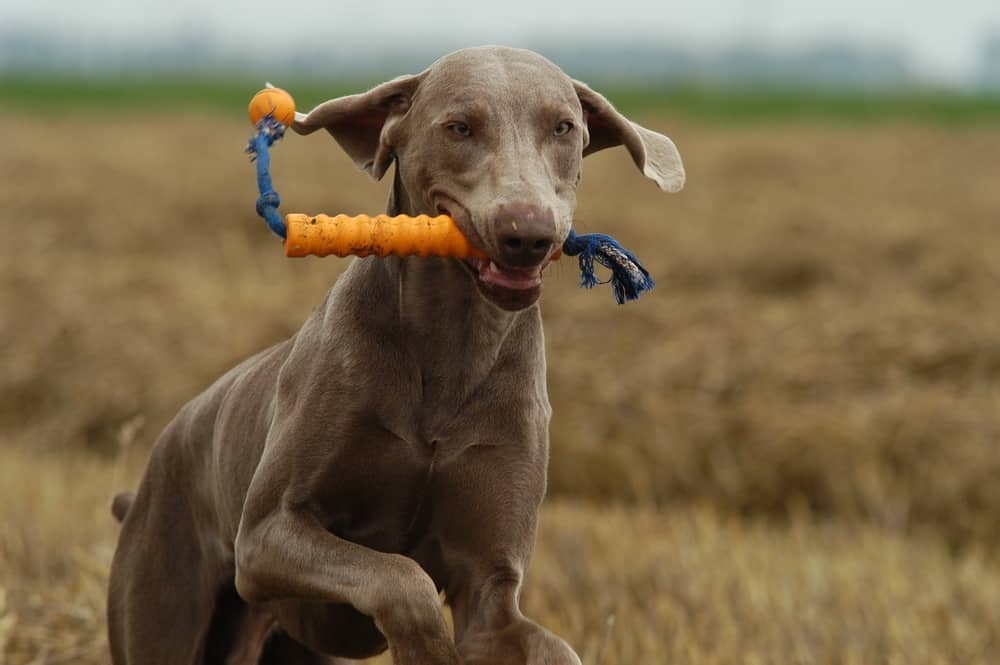Complete Guide To The Weimaraner: Care, Feeding, Exercise and More
The German-bred Weimaraner is a prince among dogs. Proud but never preening, its distinctive appearance will catch your eye, but its warmth, intelligence and athleticism will forever capture your heart.
I’ve seen quite a few Weimaraners in my 35 years of working with dogs (the last 20 as a veterinarian). The following information is based on that experience as well as many conversation had with Weimaraner owners over the years.
Table of Contents
How Big Do Weimaraners Get?
Weimaraners are large dogs with a sturdy, muscular build. Weighing in at 55–90 pounds, they stand tall at 23–27 inches, striking a balanced, confident pose. Their wide chest and brawny shoulders slope gently toward a lean midsection and hindquarters built to sprint.

What Can Weimaraners Look Like?
Long ears, a graceful muzzle, and piercing blue or amber eyes give the Weimaraner an aristocratic, almost brooding look that belies its cheerful demeanor. Their coat is short and sleek with a velvet-like texture in shades of blue, gray or silver — small white marks on the chest are common and don’t disqualify dogs from shows. Tails are docked to six inches long.
Similar in size and conformation to the German Shorthaired Pointer, the Weimaraner’s unique color sets it apart. The Hungarian-bred Vizsla is closest in appearance but is significantly smaller with a trademark golden/orange coat.
What Kind Of Personality Do Weimaraners Have?
Weimaraners are the quintessential sporting dog. They thrive on human companionship, but they’re built to run — a mere walk is a letdown.
Willing and eager to please, they’re ideal companions for active families and enjoy hunting and agility competitions — no game is too challenging. Loyal, they’re good protectors and friends for older children, but they’re built for the outdoors and will struggle if left alone for long periods or confined to small spaces.
Astute and persistent, they know how to get their way. If they could speak, their favorite word might be “no.” Early socialization and training classes are recommended to channel their intelligence and enthusiasm in positive ways.
What Are The Grooming Needs Of A Weimaraner?
Weimaraners shed regularly and seasonally, but the good news is, their coats are short, so they’re not challenging to keep up with. Twice per week brushing with a medium-bristled brush or grooming mitt thins dead hair and keeps it off your clothes — keep the Dustbuster handy in the springtime.
An occasional bath is plenty unless they’ve been in bog water — hunting dogs instinctively roll in interesting scents to glean information for their pack. More of a challenge is ear and nail care.
Weimaraners’ long, heavy pinnae impede airflow, creating the warm, dark, moist conditions that lead to ear infections. Cleanse them monthly with a pH-balanced solution to remove wax and prevent irritation.
A Weimaraner’s nails tend to grow quickly despite their vigorous activity. A good rule is — if you hear them click, it’s time to clip. When nails get too long, it takes time to work them back to their preferred length, leaving energetic outdoor dogs at risk of injury. Trim or file them every few weeks.
How Long Do Weimaraners Live?
10-13 years based on information gathered by the American Kennel Club (AKC)
What Health Concerns Do Weimaraners Have?
Weimaraners are typically very healthy dogs and end up with few health conditions for the most part. The biggest ones you’ll watch out for include:
- Arthritis
- Torn ACLs
- Bloat/GDV
- Hypothyroidism
Do Weimaraners Have To Have Their Tail Docked?
No, they don’t but it’s still very common. When done within a few days of birth by a skilled veterinarian, this is a procedure that can benefit the dog from potential tail injury in the future. The National Breed Club still advocates for tail docking and dewclaw removal at a young age and I agree with them.
It’s becoming a bit more common to see a Weimaraner with their tail nowadays. They do have very strong tails, however, so watch out if you are on the south side of one of these powerful dogs. Because of this, they can be predisposed to having tail trauma (“happy tail”) if they hit their tail up on objects frequently.

What Kind Of Dog Food Is Best For Weimaraners?
For Weimaraner puppies, you will need to make sure you don’t feed them too much too fast. It’s easy because they are usually chow hounds, but you want to control their growth. Growing too fast can cause some early bone and joint problems that are easily avoided.
Best Puppy Food For Weimaraners:
Best Adult Food For Weimaraners:
Please don’t listen to the folks at the pet store trying to convince you to buy a grain-free diet for your dog. There’s zero science behind that and vets are actually seeing diseases now related to feeding grain-free foods.
How Much Exercise Do Weimaraners Need?
How much time do you have? This isn’t a dog for someone who doesn’t have time for a dog in their life. This is the perfect dog for someone who wants to team up and hike mountain paths, run a 5k with their dog, and even do more advanced training. They’re used in agility, field trials, advanced obedience, and even search and rescue.
Weimaraners crave exercise like a Golden Retriever craves love and attention. If they don’t have it, they will find something to do and it likely won’t be anything productive. These dogs need long sessions of heavy exercise to feel content and happy.
I actually had a client once who built a series of multi-level wooden platforms in his backyard so his dogs could actually run up onto his roof. They treated it like a mountain climb and could be seen down the block every day. His dogs were very healthy and happy, too.
I don’t recommend letting the vast majority of dogs climb up onto the roof of a house, so you’ll have to find other ways to exercise your dog heavily.
Where Can I Find Weimaraners?
Weimaraner Club of America’s Recommended Club List (you can get a good breeder referral)
Just Weimaraners website’s Fantastic List Of Rescues
Where To Find More Information About Weimaraners
60 Second Lesson On Weimaraners
Search for a local club
Interesting Facts About Weimaraners
From their appearance to their personality, Weimaraners are an enchanting breed. But here are a few things you may not know about this gracious, genial dog.
• Weimaraners are Distinctly German
It was none other than Germany’s Grand Duke Karl August who spearheaded efforts to develop the Weimaraner in the 1800s. A true sportsman, he bred bloodhounds with other European hunting dogs to produce a one-of-a-kind big game hunter with a keen sense of smell.
• They Were a State Secret
The German aristocracy once guarded the Weimaraner so jealousy that ordinary citizens weren’t able to have one. Ownership was limited to members of the Weimaraner Club of Germany — an organization solely attended by nobles. Male dogs that were left to non-nobility were castrated to prevent unauthorized breeding.
• It was a Long Trip To America
Weimaraners were finally sold to an American, Howard Knight, in 1929. But much to his surprise upon returning stateside, he discovered they were neutered. Undeterred, it took him nearly a decade to get breeding dogs, but the rest is history — the American Weimaraner Club was founded in 1941, and the breed was recognized by the AKC just two years later.
• They’re Enthusiastic Transplants
Despite the Weimaraner’s popularity in Europe, their role was limited to hunting. But since coming to the United States, they’ve participated in more hunting, agility and show competitions than during their entire development in Germany.
• Weimaraners Are Pop Art Icons
American photographer William Wegman is best known for his delightful art featuring Weimaraners. Graduating from shooting pictures of them in elaborate costumes, he developed short, interactive videos that were regularly seen on Jim Henson’s Sesame Street.
• They’re Heroes, too.
Weimaraners have discriminating noses. Prized search and rescue dogs, they’ve saved missing persons and served the US during the Cold War, finding pieces of test missiles in the desert, so scientists could study their function.
• Weimaraners Can Have Long Coats
Weimaraner typically have short coats, but there’s a rare, longer-haired variety. The trait is caused by a recessive gene and frowned upon by the AKC — long hair is a disqualification. But fans are keeping the characteristic alive through selective breeding.
• They’re Born With Stripes
Weimaraner puppies are born with silver-gray stripes that disappear a few weeks after birth. During that same time, their haunting blue puppy eyes transition to a deeper blue-gray or amber hue.
• Famous Dogs for Famous Owners
Weimaraners don’t have much Hollywood street cred, but they’ve had a few distinguished owners, including American film actor Brad Pitt, former US President Lyndon B. Johnson and Grace Kelly, actress and Princess of Monaco.
